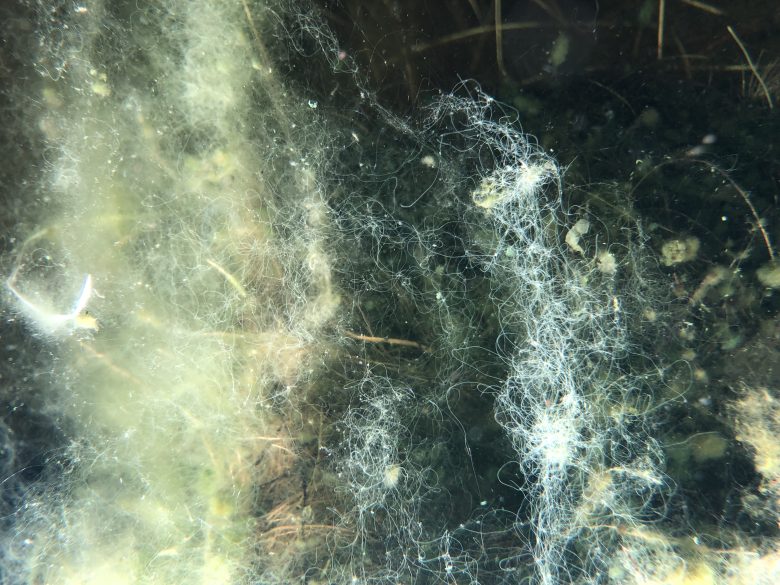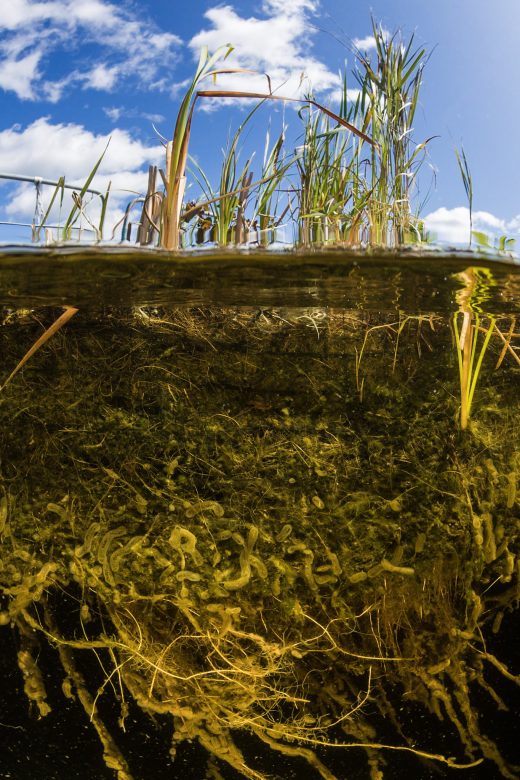Research August 14, 2019
Bioremediation: Harnessing nature to manage and restore our environment
By Madeline Stanley, Project Officer, Richard Grosshans, Bioeconomy Lead
Freshwater systems around the world are under stress.
Unsustainable demands for water, increasing risks of contamination from new pollutants and the impacts of climate change have all resulted in an urgent need to restore our ecosystems and the critical services they provide for us.
Restoration of our ecosystems requires management at the source and at the site. It includes policy changes to enforce reductions at point sources and nonpoint sources, as well as on-the-ground applied management.
Treatment of pollutants and contaminants using plants and natural systems has been used in a variety of forms for centuries. In ancient Europe and China, it was often as simple as realizing how the water was cleaner after running through a wetland or by adding fish to a pond.
Restoration can happen through chemical or physical engineering and manipulations or through biological treatment processes, also known as bioremediation.
What is bioremediation?
Bioremediation is the process of treating and detoxifying environmental contaminants in soil, water or other environments by taking advantage of natural biological processes.
It can be done using plants (phytoremediation), microbes (biostimulation), fungi (mycoremediation) or even animals such as fish (biomanipulation). These biological processes can be enhanced to make them even more effective, for example, by fertilizing to produce more available nutrients or by adding specialized organisms to stimulate degradation of the target pollutants.

The plants in floating treatment wetlands uptake nutrients and contaminants themselves, but it is the layer of biofilm coating the roots that performs most of the uptake and degradation of nutrients, toxins and contaminants.
Pollutants and contaminants have been treated using plants and natural systems in a variety of forms for centuries. In ancient Europe and China, it was often as simple as realizing how the water was cleaner after running through a wetland or by adding fish to a pond.
Why use bioremediation?
Modern bioremediation options offer a low-cost solution for treatment and tend to be less invasive: they work to enhance existing biological processes without causing serious manipulations that may disrupt an already stressed ecosystem. During a period of contamination, the ecosystem may already be under stressful or harsh conditions and in need of restoration.
What are floating treatment wetlands (FTWs)?
Natural wetlands can improve the water quality of stormwater runoff and manage watershed nutrients, as well as treat wastewater and other industrial contaminants. They rely on natural processes to biologically filter water as it passes through shallow areas of dense aquatic vegetation and permeable bottom soils.
FTWs, or islands, are small artificial platforms that allow aquatic emergent plants to grow in water that is typically too deep for them. The network of roots spreads down through the floating island into the water column, stimulating biofilm development (algae, bacteria, fungi and microbes).
How do FTWs work?
The plants uptake nutrients and contaminants themselves, but it is the layer of biofilm coating the roots that performs most of the uptake and degradation of nutrients, toxins and contaminants. Together, plants and biofilm conduct various forms of bioremediation, from phytoremediation to biostimulation to rhizofiltration, and promote the development of invertebrate communities that may provide food for fish and other aquatic insects. In fact, FTWs are also used to enhance fish productivity and bird-nesting habitats: they were recently used to restore an estuary in Ecuador.
For the past decade, IISD Experimental Lakes Area (IISD-ELA) has been exploring the use of plants and floating wetlands for the bioremediation of nutrients and other contaminants from freshwater systems.

FTWs are a proven method for nutrient and contaminant treatment in many scenarios, but their ability to remediate oil and hydrocarbons from water is a growing area of research.
Could FTWs be used to clean up oil spills?
Now we want to discover how effective FTWs could be to clean up oil spills in freshwater lakes. This research is part of a larger study into effective methods to clean oil from freshwater shorelines and the ecological effects on various levels of the ecosystem, from microbes to fish.
FTWs are a proven method for nutrient and contaminant treatment in many scenarios, but their ability to remediate oil and hydrocarbons from water is a growing area of research. IISD-ELA is the only place on Earth where you can simulate an oil spill in a real lake and study the interrelated impacts on the ecosystem.
FTWs, or islands, are small artificial platforms that allow aquatic emergent plants to grow in water that is typically too deep for them. The network of roots spreads down through the floating island into the water column, stimulating biofilm development.
After an oil spill, natural recovery by microbe communities in shorelines and substrate may be limited by surface area. Floating wetlands can provide the expanded surface area and resources for microbial development, with the potential to support and stimulate microbes known to degrade the hydrocarbons found in oil.
As this research continues, we want to learn if engineered FTWs are a cost-effective and non-invasive bioremediation strategy for oil spills in fresh water.
What other uses could they have?
In 2015, we used FTWs on IISD-ELA lakes to study how cattails absorb phosphorus—an excess of which lead to algal blooms. This research showed how excess phosphorus in a phosphorus-rich lake enhances cattail growth and uptake, compared to a nutrient-poor lake. We also discovered that seven times more phosphorus is absorbed in the roots than in the plant above.
In 2016 and 2017, studies were carried out at the University of Manitoba using small FTWs to grow cattail plants, to explore how they could remove pharmaceuticals and herbicides from water. These studies revealed cattail and associated biofilm growing on FTWs did in fact reduce levels of certain micropollutants added to the water, suggesting that FTWs could be a viable treatment option. They also revealed that the more invasive hydrid cattail is becoming resistant to glyphosate herbicide, which has management implications for the use of herbicides to control invasive plants.
In 2018, a floating wetland was planted and deployed in a stormwater pond in Lorette, MB, to demonstrate FTWs for improving stormwater runoff. Stormwater retention ponds in urban and rural areas receive varying load rates of nutrients such as nitrogen and phosphorus from surrounding land runoff and can develop very poor water quality, odour issues and outbreaks of algae. We want to see if FTWs remove these nutrients and reduce water quality issues, making them an effective bioremediation option for urban, rural and agricultural runoff.
In 2019, a large FTW was deployed in Dunnottar, Manitoba’s secondary wastewater lagoon, to study the effectiveness of this type of wastewater treatment. Initial results show exceptional growth of island plants and duckweed, and we anticipate excellent nutrient and contaminant bioremediation benefits.
But we won’t stop there.
Opportunities for the use of FTWs for bioremediation are endless. Future potential research may include metals, pharmaceuticals and even microplastics.